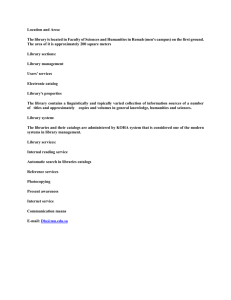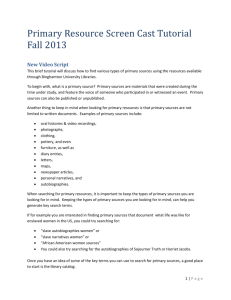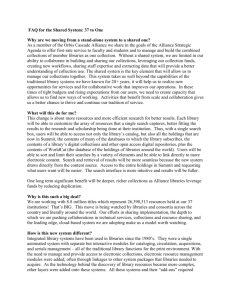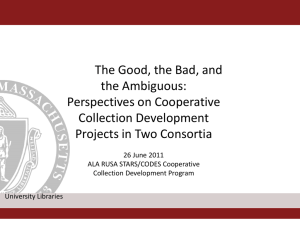The Tompkins-Seneca-Tioga BOCES School Library System has
advertisement
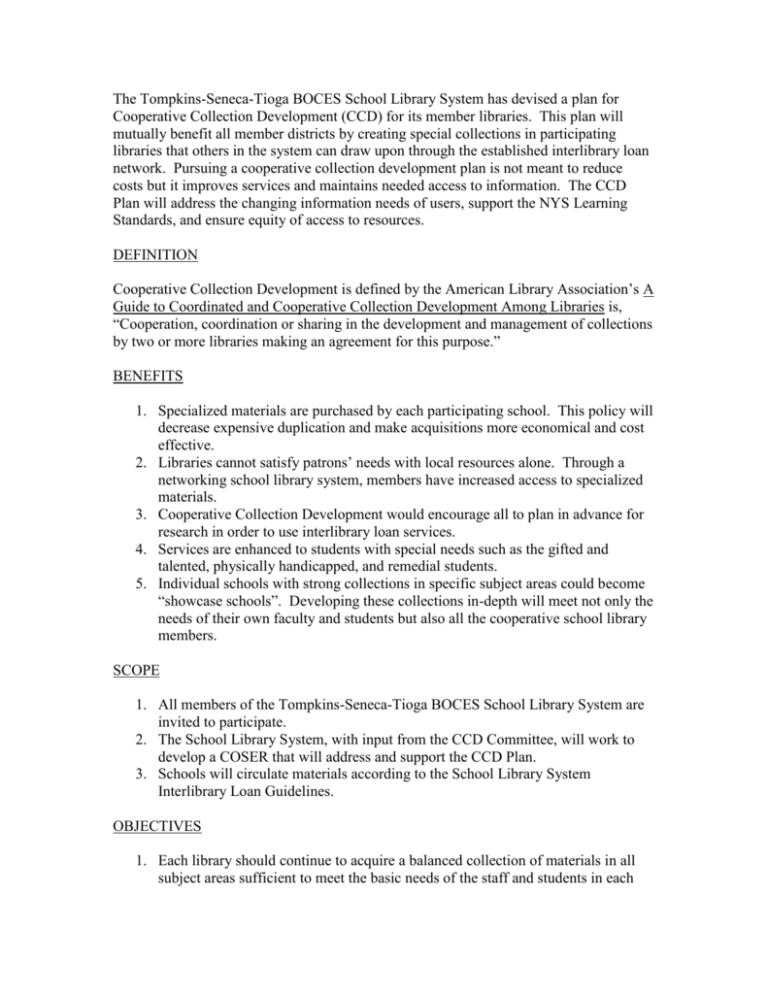
The Tompkins-Seneca-Tioga BOCES School Library System has devised a plan for Cooperative Collection Development (CCD) for its member libraries. This plan will mutually benefit all member districts by creating special collections in participating libraries that others in the system can draw upon through the established interlibrary loan network. Pursuing a cooperative collection development plan is not meant to reduce costs but it improves services and maintains needed access to information. The CCD Plan will address the changing information needs of users, support the NYS Learning Standards, and ensure equity of access to resources. DEFINITION Cooperative Collection Development is defined by the American Library Association’s A Guide to Coordinated and Cooperative Collection Development Among Libraries is, “Cooperation, coordination or sharing in the development and management of collections by two or more libraries making an agreement for this purpose.” BENEFITS 1. Specialized materials are purchased by each participating school. This policy will decrease expensive duplication and make acquisitions more economical and cost effective. 2. Libraries cannot satisfy patrons’ needs with local resources alone. Through a networking school library system, members have increased access to specialized materials. 3. Cooperative Collection Development would encourage all to plan in advance for research in order to use interlibrary loan services. 4. Services are enhanced to students with special needs such as the gifted and talented, physically handicapped, and remedial students. 5. Individual schools with strong collections in specific subject areas could become “showcase schools”. Developing these collections in-depth will meet not only the needs of their own faculty and students but also all the cooperative school library members. SCOPE 1. All members of the Tompkins-Seneca-Tioga BOCES School Library System are invited to participate. 2. The School Library System, with input from the CCD Committee, will work to develop a COSER that will address and support the CCD Plan. 3. Schools will circulate materials according to the School Library System Interlibrary Loan Guidelines. OBJECTIVES 1. Each library should continue to acquire a balanced collection of materials in all subject areas sufficient to meet the basic needs of the staff and students in each school. Through collection assessment, each school could assess their collection’s strengths and weakness in all subject areas. 2. Each library should: a. Identify its current areas of strength b. Insure the preservation of these materials c. Continue to build this collection COLLECTION PLANNING PHASES Each participating school in cooperation with the CCD committee will be completing the following phases towards developing a cooperative collection Step One: Select one or more periodical titles to be preserved and continue to collect Step Two: Select one or more sources of reference materials to be preserved and collected. Step Three: Select an appropriate area of materials (print, non-print and/or electronic) to be preserved and collected as an emphasis area. PROCEDURES Step 1: Periodicals 1. The Cooperative Collection Development (CCD) committee has drawn up a list of periodical titles which have been submitted to each school library system member who in turn have committed themselves to preserve these periodical titles and continue to hold for specified number of years. 2. The Union List of Periodicals indicates the depository school for each designated periodical title. Step 2: Reference Materials 1. Each school library has submitted to the CCD committee a list of three or more reference sources which they have agreed to keep current. 2. The committee has coordinated these lists and designated the reference title(s) and the holding libraries. 3. The system has provided each member with a list of the reference materials and depository libraries. Step 3: Monographs 1. Each school library will submit to the CCD committee a list of three or more areas of strength in categories for their emphasis area meeting the needs of their school’s curriculum. 2. The committee will coordinate these lists and designate the holding libraries for these specialties. 3. The system will provide its members with a list of these libraries and their specialties. SELECTING AN EMPHASIS AREA Picking a narrow field of concentration for a specialty area has advantages and disadvantages. ADVANTAGES 1. Each librarian will be working within a limited subject area which should require only a minimum amount of time. 2. The limited scope should not be a strain on the librarian’s time 3. The collection emphasis will generally support a single research subject. 4. Bibliographies of this collection will be easier to compile 5. Small collection areas will take less time for evaluation. DISADVANTAGES 1. The holding school may eliminate the emphasis area from their collection. 2. The holding school curriculum may change and the school may no longer wish to collect in that area. 3. If little is published in emphasis area, librarian may purchase quantity rather than quality. THE COLLECTION AND NATIONAL SELECTION LISTS Comparing a school’s collection with national selection lists may or may not prove helpful. Since these standards may not match a particular school’s curriculum, they might be used as a preliminary step in the identification of emphasis collections. Nationally recognized selection lists: Elementary School Library Collection, Middle and Junior High School Library Catalog, and the Senior High School Library Catalog were used to recommend percentages for each Dewey area for elementary, middle and junior high and high schools. It is still the work of the library media specialist to adapt any basic list to local needs, selecting for special curricular projects, and keeping the collection up-to-date through judicious weeding and continuous evaluation. Keep in mind that the total collection chart will not help identify emphasis collections that would span several Dewey classes. Research shows that on the average, library media specialists build different collections than these lists recommend, especially if curriculum mapping is being closely adhered to by the library media specialist. There is an over-abundance of emphasis in these lists on fiction in the junior and senior high level, however, when funds are limited, it would seem wiser to concentrate purchases in the non-fiction areas. COLLECTION BUILDING Building the school library collection should be a systemic method of taking the collection from where it is to where it should go. Questions to ask are: In what areas should purchases be made? Once that problem is solved, what will actually be purchased? School based collections are established primarily to supplement curriculum. Selection should be focused to avoid errors which involve time and money. School library collections should be flexible to meet the changing and increased demands of the curriculum. To maintain an active flexible collection, it is important to not only add, but delete and discard those materials no longer appropriate and pertinent to the collection. BUDGETING 1. The designated holding library should make definite purchases that will be a part of the core collection as first choice. 2. Second choice purchases can be added to the collection as supplemental materials as funds become available. 3. Schools other than holding libraries should avoid first or second choices and as third choice purchase materials that would be beneficial in supporting curriculum projects. 4. Other schools may make suggestions to the holding school for purchases; however, the holding library is under no obligation to comply. COLLECTION ASSESSMENT Collection assessment is critical to CCD. The School Library system will support this effort by participating in opportunities to learn more about new techniques for qualitative and quantitative analysis. Specifically, procedures outlined in Debra Kachel’s book, Collection Assessment and Management of School Libraries, will be explored and practiced. Although librarians will be assigned a group of specialization by the CCD committee, it will be their responsibility to gauge the relative strength of their present collections. Thus, further monies spent to enhance the collection can be put to the most efficient use. A collection that will support most instructional levels will require a maintenance of materials for limited or generalized purposes, of less than research intensity. It includes a wide range of basic monographs, complete collections of the works of more important writers, selections from secondary writers, representative journals, reference and fundamental bibliographical tools relative to the subject. Methods of collection analysis can also include: 1. Analysis of individual monographs and reference material presently in the collection, copyright, general condition of the material, etc. 2. Analysis of the availability of materials through annual inventory 3. Consultation with subject specialists or other teachers who may have familiarity with the collection 4. Comparison with subject specialists or other teachers who may have familiarity with the collection. AAAs Science Booklist Books for Secondary School Libraries Children’s Catalog Choice Elementary School Library Collection Fiction Catalog A Guide to Historical Reading Guide to Reference Books for School Media Centers Junior High School Library Catalog Library Journal Magill’s Bibliography of Literacy Criticism Recommended Reference Books for Small & Medium Size Libraries and Media Centers School Library Journal Senior High School Library Catalog 5. Local effects of curriculum changes, especially those in support of the NYS Learning Standards. COLLECTION DEPTH The following are indicators of collection depth which may be examined and assessed. Every teacher planning a unit of instruction may expect: 1. A variety of media (print, non-print and/or electronic) 2. Materials which are current (as called for by the topic studied) 3. Materials relevant to needs. 4. Materials which are durable and in good repair. 5. Enough materials for the number of students studying the unit. 6. Materials which span the reading/viewing/listening/comprehensive levels of the students. 7. Materials which appeal to student interests 8. Materials which span opinion/cultural/political issues if appropriate. 9. Ease of access to materials, equipment and facilities given reasonable time for planning. 10. The best of new materials purchased for the unit. EVALUATION OF CCD To assist in an evaluation of the CCD projects, we request that each holding school keep a bibliography designating: 1. The number of items owned in the emphasis area by the library prior to CCD 2. The number of items added during the school year that CCD was implemented STORAGE AND DISCARD DECISIONS Consideration will undoubtedly have to be given to storage of new materials purchased. Considerable weeding may have to be undertaken to make room for the new materials. Extra space may have to be allotted to accommodate a larger collection in the school’s area of specialization. Materials selected by a particular school for discard should be listed and send to the System office so that other schools will be notified before actual discard. RESPONSIBILITIES OF THE SCHOOL LIBRARY SYSTEM 1. Collecting and coordinating the lists of emphasis areas from each participating schools library. 2. Yearly review of the effectiveness of the emphasis area specializations. 3. Review requests and keep schools informed about changes or redirection of emphasis areas in individual school libraries. 4. Annual review of the guidelines. 5. Continued coordination of the CCD program to promote the implementation of these guidelines. Once a CCD COSER is in place: 6. Coordinating purchase orders, processing, stamping and distribution of materials. 7. Keeping schools informed about coser requirements.




